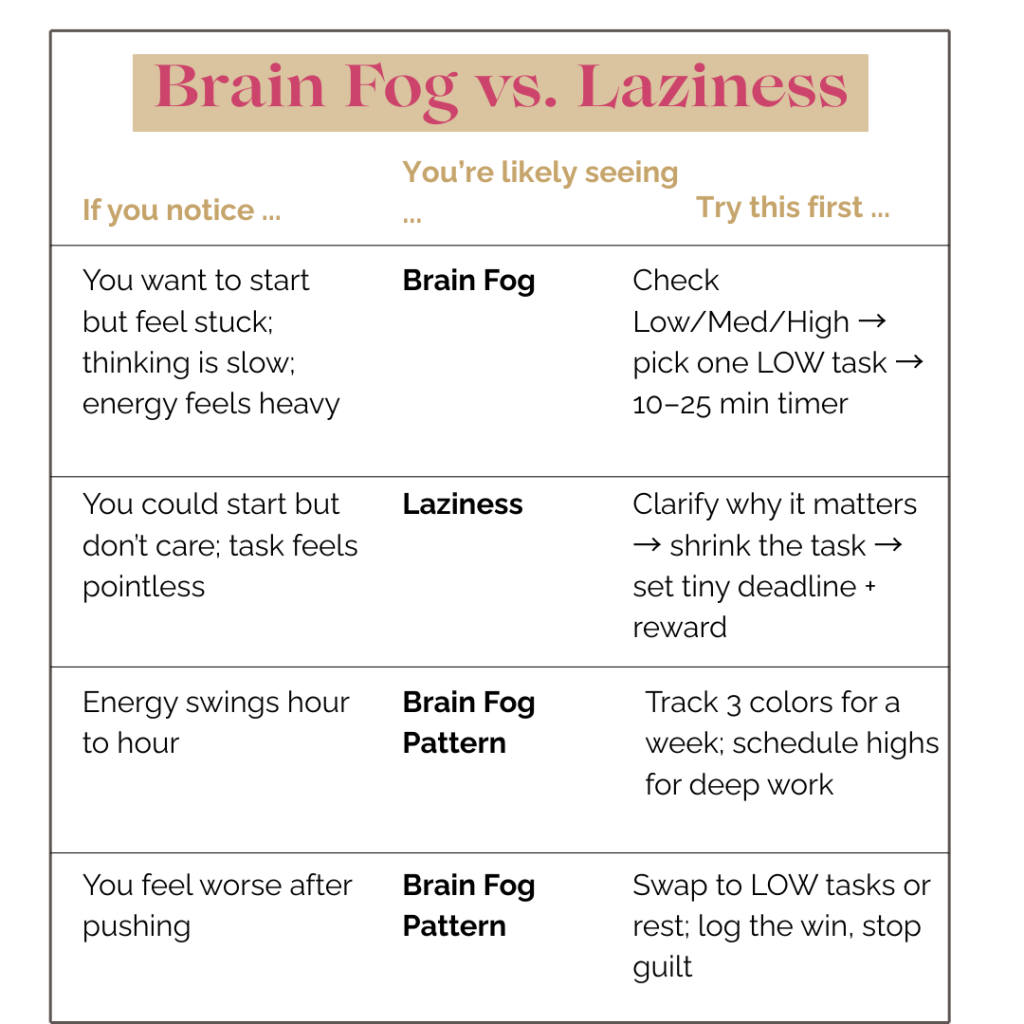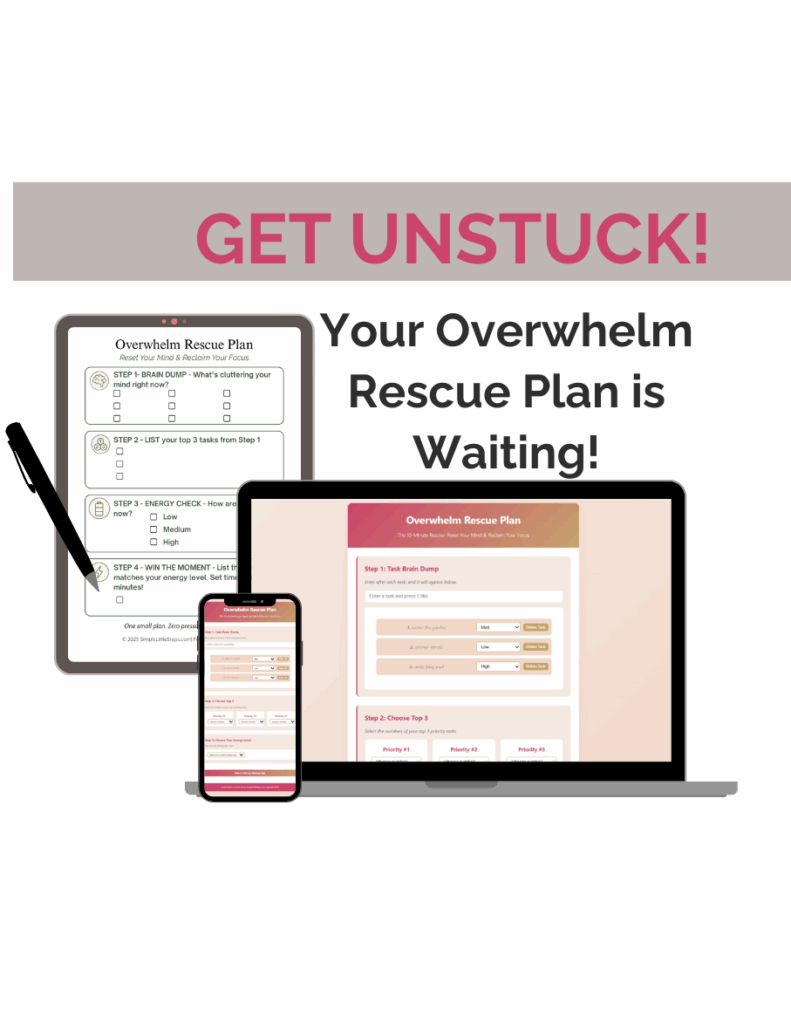Brain Fog vs Laziness: You’re Not Lazy—Here’s What’s Really Going On
If you’ve ever wondered whether your struggles are brain fog or laziness, you’re not alone. This guide explains the difference and how to move forward.
- What Is Brain Fog (and Why It Feels Like Laziness)
- Brain Fog vs Laziness: The Key Differences
- Common Signs of Brain Fog
- How We Internalize Brain Fog as Failure
- Quick Steps to Get One Thing Done (Even with Brain Fog)
- Questions to Ask When You Think You Have Brain Fog
- FAQ
- Your Next Step: The Overwhelm Rescue Plan (10-Minute Reset)
What Is Brain Fog (and Why It Feels Like Laziness)
When your personal energy is low, a normal schedule works against you. That’s brain fog, not laziness—your focus, memory, and decision-making slow down, which makes starting feel heavy.
Here’s the truth: brain fog is not a character flaw. It’s a physiological and emotional signal—your brain’s way of saying, “I’m overloaded. I need support.” When we respond to that signal with compassion and strategy, we move toward clarity and calm living, and our focus and productivity return.
Brain Fog vs Laziness: The Key Differences
Brain fog has many inputs, and none of them are “laziness.”

- Stress. Chronic stress elevates cortisol and keeps the nervous system on high alert. That state pulls energy toward survival and away from planning, memory, and decision-making—key parts of executive function. Result: slower thinking, shorter attention, more “why did I come into this room?” moments.
- Sleep disruption. Inconsistent or poor-quality sleep reduces your brain’s ability to consolidate memory, regulate mood, and clear metabolic waste. Even one night of poor sleep can make your thoughts feel sticky; a string of them compounds the fog.
- Decision fatigue. Every choice—what to wear, what to cook, which email to answer—uses cognitive fuel. Hundreds of micro-decisions a day drain that fuel, leaving you scattered and more prone to task-switching and procrastination. This means that even seemingly insignificant decisions, like what to have for breakfast or what to wear, can contribute to your brain feeling ‘foggy’ later in the day.
- Hormonal shifts. Fluctuations related to menstrual cycles, postpartum changes, thyroid function, and menopause can all affect processing speed, working memory, and mental stamina.
Busting the Myth:
We tend to explain foggy thinking with willpower stories: “try harder,” “be more disciplined,” “stop being lazy.” But brain fog is a capacity issue, not a character issue; it reflects stress load, sleep quality, decision volume, and hormonal shifts. When you name it accurately, you can choose supports that restore focus and productivity instead of piling on shame. This reframe is the foundation for overcoming brain fog and returning to a life of clarity and calmness with a kinder mindset, which we’ll address further below.
- Myth: “If I just had more willpower, I wouldn’t feel like this.”
Reality: Willpower can’t override an overtaxed nervous system. “Low motivation” is often a downstream effect of brain fog, not a moral failing. - Myth: “People who get things done aren’t tired or distracted.”
Reality: High performers use scaffolding—routines, lists, and boundaries—to offload working memory and protect attention when capacity dips. For instance, they might use a task management app to keep track of their responsibilities, or they might establish a daily routine to reduce the number of decisions they have to make each day. - Myth: “Resting or stepping away wastes time when I’m behind.”
- Reality: Short resets (movement, hydration, breath, light) help the prefrontal cortex come back online, clearing mental static and improving focus and productivity faster than pushing through the fog.
Common Signs of Brain Fog
Brain fog isn’t just “being tired.” It’s a cluster of cognitive, sensory, and emotional signals that can masquerade as laziness if you don’t know what to look for. Here are subtle signs—and how they affect focus and productivity—so you can start overcoming brain fog with a kinder mindset.
1) Trouble Recalling Words (and Names)
You know precisely what you want to say, but the word won’t surface. Conversations stall, writing slows, and you feel strangely “blurry” around language.
Example: You’re presenting a simple update and pause mid-sentence to chase a basic term like “spreadsheet.”
Why it’s brain fog (not laziness): You want to contribute; retrieval is the block. This is working-memory overload, not a lack of effort.
Try this: Keep a “placeholder” habit—describe the idea (“the budget list tool”) and move on. Jot missing words on a sticky; they often pop up once pressure drops.
2) Constant Task-Switching
You open a tab to send one email and end up skimming three articles, checking a calendar, and reorganizing a folder—finishing none of it.
Example: Ten open tabs, five half-starts, zero completions.
Why it’s fog: Your brain is hunting micro-dopamine because sustained focus feels too “expensive.”
Try this: 20-minute focus sprint with a visible timer + one-line “win goal” (e.g., “Send the draft”). Hide or close everything else. Celebrate the micro-finish.
3) Feeling “Off” Without Explanation
You’re not sick, but everything is 20% harder—time blurs, patience thins, and everyday tasks feel weirdly complex.
Example: You re-read instructions twice and still feel unsure where to start.
Why it’s fog: Cognitive bandwidth is low; decision-making and sequencing are taxed.
Try this: Name it (“Fog day”), reduce inputs (fewer notifications/bright screens), and switch to clarity and calm living tasks—outline instead of draft, prep instead of finalize.
4) Time Blindness
Minutes vanish or stretch; estimating how long something will take feels impossible.
Example: A “quick reply” eats 40 minutes; a simple chore takes all afternoon.
Why it’s fog: When executive function is taxed, internal timekeeping goes wobbly.
Try this: Externalize time. Set a single timer for the whole task and a halfway check (“At 10 minutes, assess progress and either continue or park it”).
5) Misplacing the Basics
Keys, phone, glasses—your essentials migrate constantly.
Example: You lose five minutes before every call hunting for headphones.
Why it’s fog: Working memory is saturated; small details slip.
Try this: One “landing zone” per item. Pair it with a verbal tag: “Glasses on the tray.” It’s boring—and wildly effective.
6) Sensory Overload
Noise, bright lights, or dense visuals feel like static in your head.
Example: The open office (or Slack pings) makes simple tasks feel impossible.
Why it’s fog: Overstimulation drains the same resources you need for focus.
Try this: Reduce inputs (noise-cancelling, grayscale phone, Do Not Disturb). Protect one quiet block for deep work.
7) Emotional Edginess & Low Motivation
Irritability, impatience, or sudden “I just don’t want to” vibes.
Example: You bail on a task you care about and wonder, “What’s wrong with me?”
Why it’s fog: “Low motivation” is often a downstream effect of cognitive overload. Your system is signaling capacity limits, not character flaws.
Try this: Micro-starts (open the doc, write one sentence). Action precedes motivation; tiny wins restore focus and productivity.
Quick self-check: If you want to do the thing but can’t organize, remember, or start, then call it brain fog. If you could do it and simply choose not to because it isn’t meaningful right now—that’s preference, not a moral failing. Different solutions apply.
(If you nodded along, you’re not lazy—you’re likely navigating cognitive overload. Naming it is step one in overcoming brain fog.)
How We Internalize Brain Fog as Failure
When brain fog slows us down, many of us default to a harsh story: I’m being lazy. Productivity culture equates worth with output, so any dip in clarity feels like proof of laziness rather than a sign that executive function is taxed. That mislabel adds shame on top of strain, shrinking our focus and productivity and pulling us further from clarity and calm living. A kinder mindset recognizes that fog is a capacity signal—not a character verdict—and asks what support would help right now. With that lens, the next moment becomes solvable instead of blame-worthy.
Here’s a quick story to show what that shift looks like.
A quick story:
Monday afternoon, the report is due. You’ve rewritten the opening paragraph six times and still can’t land the point. Your inner critic says, “You’re dropping the ball,” so you push harder—more tabs, more coffee, more pressure. The harder you try, the thicker the fog feels. Later that night, after a walk and an early bedtime, the sentence you needed appears in two minutes. Nothing about your talent changed. Your state did. It wasn’t failure; it was fog.
When we mislabel fog as laziness, we add shame to strain. When we recognize fog as a signal, we can shift our mindset and respond skillfully.
Quick Steps to Get One Thing Done (Even with Brain Fog)
Fog is a flag, not a flaw. It’s your dashboard light, inviting support, not self-attack. Try these gentle responses to restore focus and productivity and move toward clarity and calm living:
How to move forward today:
- Check today’s energy: Low / Medium / High
- Pick one matching task
- Set a 10–25-minute timer, then stop and log the win
Questions to Ask When You Think You Have Brain Fog
Use these prompts to shift from self-blame to strategy. They’ll help you move toward clarity and calm living, rebuild focus and productivity, and keep your mindset kind and curious.
1) Understanding Brain Fog
- Am I experiencing confusion, forgetfulness, or slower thinking than usual?
If yes, that’s likely brain fog—not laziness. Name it so you can support it. - Do bright lights, noise, or nonstop notifications make my thoughts feel crowded?
Overstimulation can thicken the fog; reducing inputs can restore clarity.
2) Exploring Root Causes
- How did I sleep last night—and this week overall?
Sleep disruptions compound fog; one honest check-in can explain a lot. - Is stress, hormonal change, or decision fatigue draining me today?
When you locate the drain, you can choose targeted relief instead of pushing harder.
3) Reframing the Story
- Am I calling this “laziness” when it’s actually cognitive overload or burnout?
Accurate language replaces shame with strategy—key to overcoming brain fog. - What would change if I believed “fog is a flag, not a flaw”?
This reframe softens pressure and opens space for supportive choices.
4) Gentle Next Steps
- What is one micro-action I can complete in under two minutes?
Action precedes motivation; a tiny win jump-starts momentum and focus. - When is my least-foggy 30-minute window, and what deserves it most?
Match task to energy to rebuild sustainable focus and productivity.
Brain fog is a flag, not a flaw—a signal that your brain needs less input and more support. When you name it, lower cognitive load, and match tasks to your current energy, you’ll notice momentum return: clearer thinking, gentler self-talk, and steadier focus and productivity. That’s the path to overcoming brain fog and living with more clarity and calm—not by pushing harder, but by working with your biology and your mindset.
FAQ
How do I know if it’s brain fog or laziness?
Brain fog feels like you want to start, but can’t access focus or momentum; laziness is choosing not to start. Fog improves when you match tasks to your current energy.
Can brain fog and low motivation happen together?
Yes—but matching tasks to your personal energy plus short timers often restores enough momentum to move.
What helps brain fog quickly?
A 10–25 minute timer on a LOW task, water, quick movement, and reducing decision load (pick one next step).
Should I push through or rest?
If you’re spent, do one tiny LOW energy task and stop. Rest is part of productivity when energy is limited.
When should I see a professional?
If fog is new, worsening, or persistent, or impacts safety/work, talk to a healthcare provider.
Your Next Step: The Overwhelm Rescue Plan (10-Minute Reset)

When your brain feels crowded and you’re tired of pushing, the Overwhelm Rescue Plan guides you through a quick reset that turns fog into forward motion. It’s designed for transformation—from scattered to steady, from foggy to focused—so you can return to clarity and calm living fast.
- A guided, fill-in form with blank spaces to capture your answers to four key prompts
- A compassionate mini-process that lowers cognitive load and sparks momentum
- You’ll receive: a printable/annotatable PDF (perfect for paper or tablet) plus access to an interactive web page that makes the reset feel twice as easy
Because you don’t need more willpower—you need a 10-minute path back to yourself.

